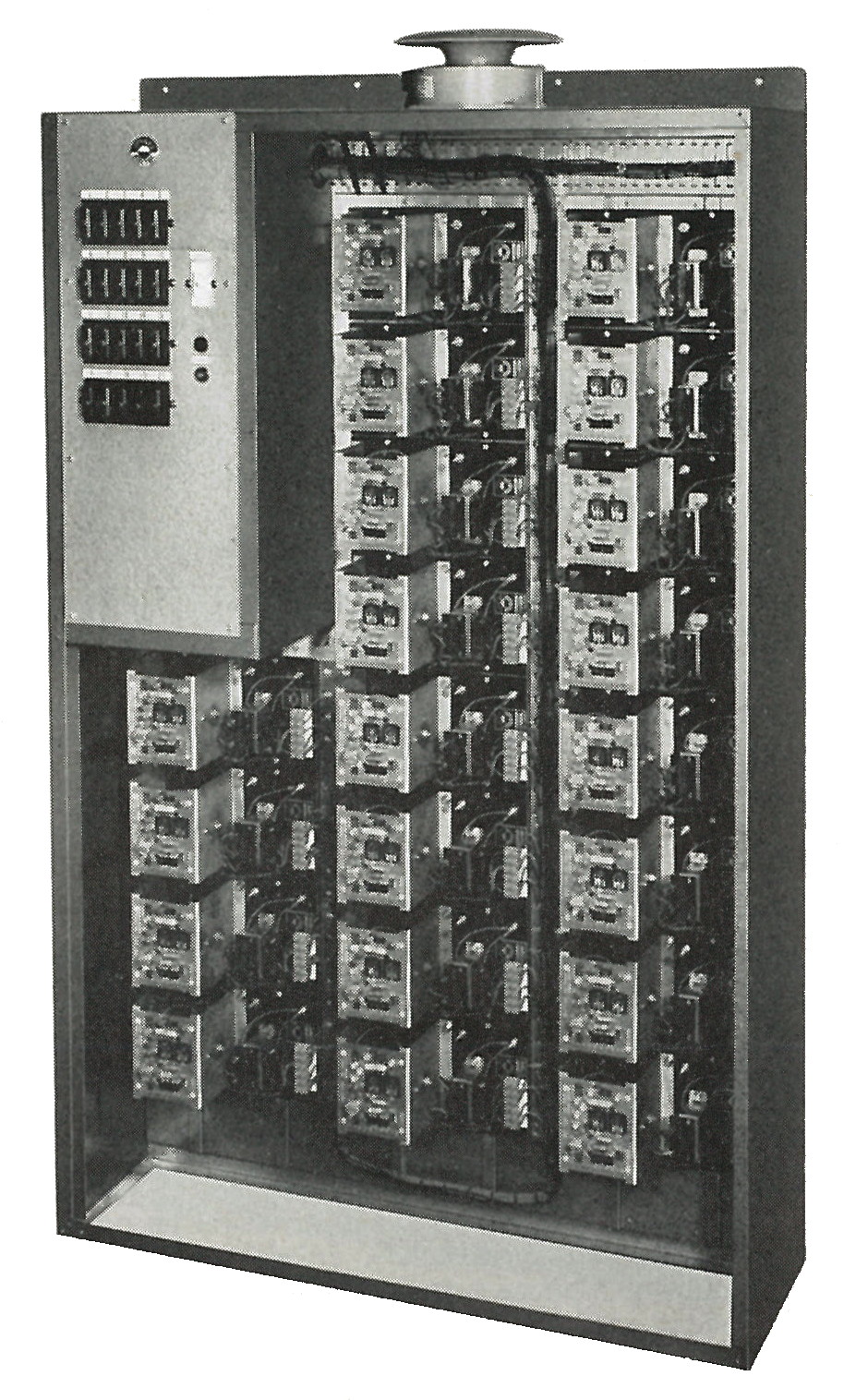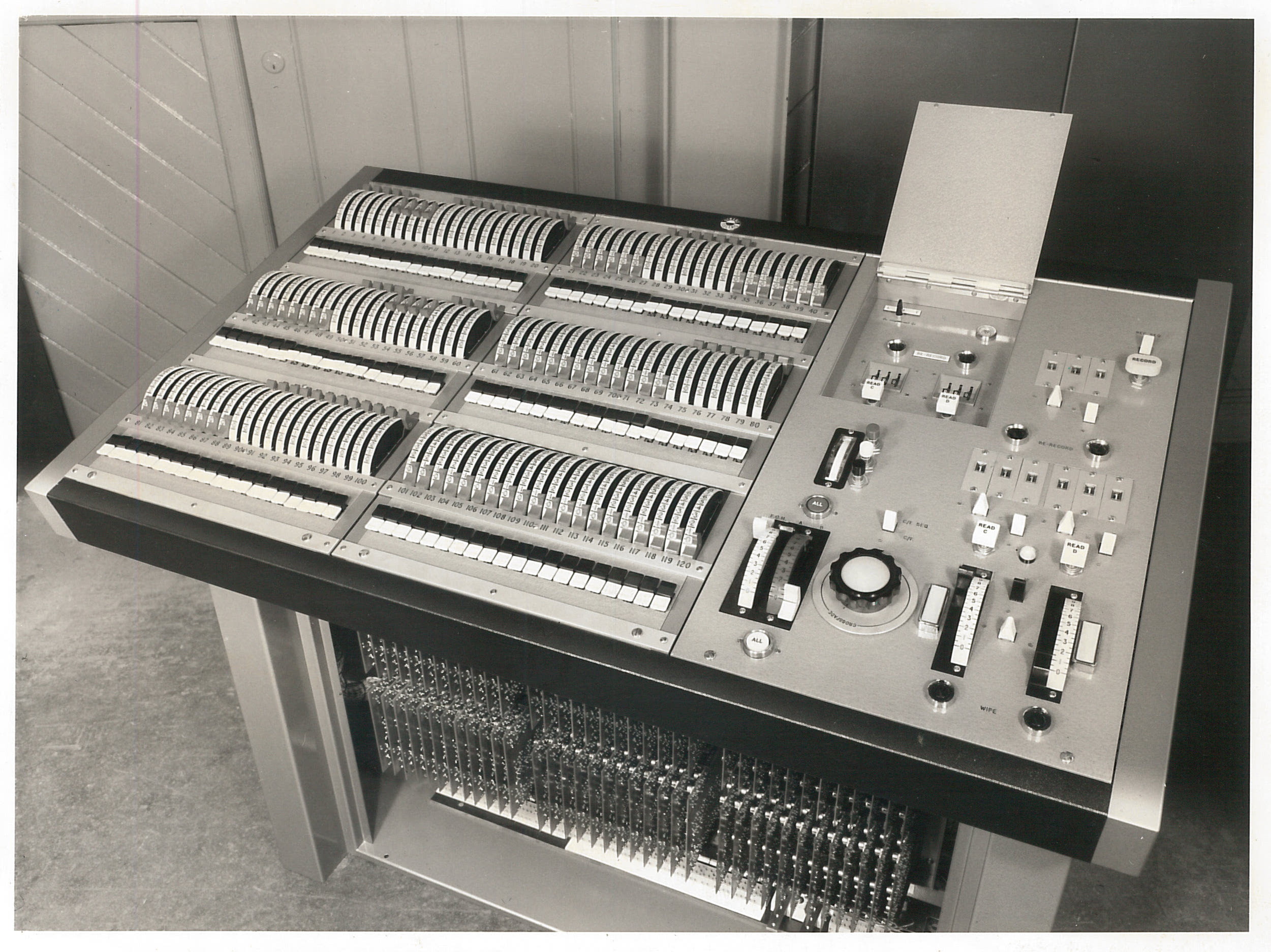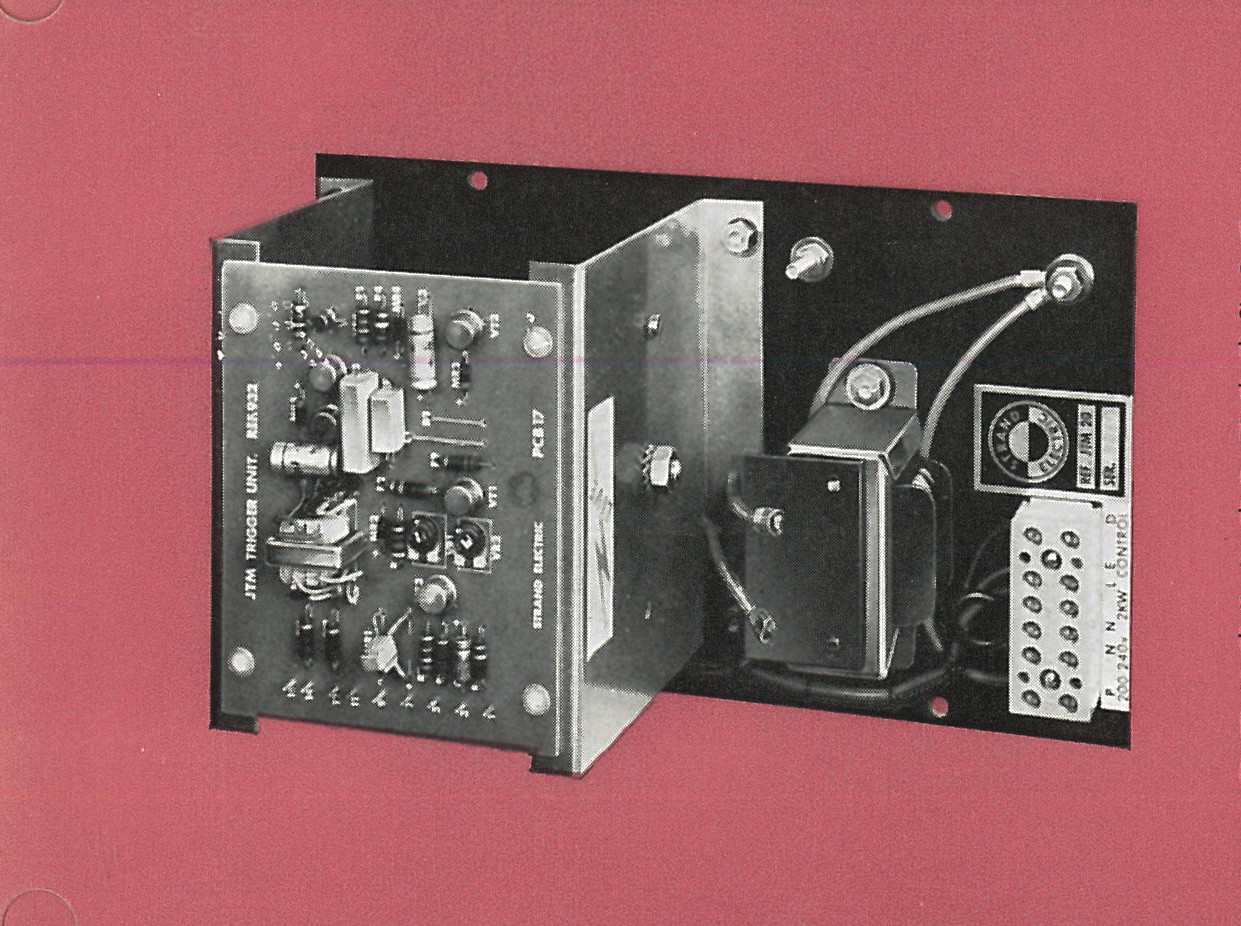Difference between revisions of "Dynamic Light"
Tag: Undo |
|||
| Line 1: | Line 1: | ||
| − | '' | + | ''Modern stage lighting is all about control: where and when do we want it, and what kind of light do we want? In the post-war period, as ambitions for lighting grew, the precise control of light levels over time was a matter of urgent importance.'' |
| − | JTM thyristor dimmer module | + | [[File:IO2 C.08 01 JTM dimmer module (c) theatre crafts.jpg|250px|thumb|left|JTM thyristor dimmer module by Stand Electric Company]] |
| − | + | Early 20th century theatre visionaries dreamt of dramatic light in constant motion, with colour dynamically shifting the audience’s emotions. James B. Fagan wrote, | |
| − | + | ''The day is not far off when we shall see the electrician an artist as well as a technical expert - seated at his switchboard like a player at an organ - sending forth rhythmic harmonies of light that shall be as music to the eyes, swaying strange sub-conscious moods in the audience, in perfect tune with the unfolding of the drama in which he himself is playing a part of no mean importance. (Q30585)'' | |
| − | + | However, having the vision was one thing – realising it technically was another. | |
| − | + | Through the first half of the 20th century, various efforts were made to develop better lighting control methods. Early [[Item:Q3922|resistance and variable transformer dimmers]] had to be operated mechanically with levers and large control wheels (Q3922, Q601). They were large, heavy and generated a lot of heat, and were therefore generally placed backstage, where the operator could not see the stage action. The need was to separate the control surface (the part the operator used to set and change the lighting) from the dimmers (the part that regulated the power going to the lamps and so their brightness). The key to splitting the control system in this way was a dimmer that could be controlled by an electrical signal sent down a small wire, rather than a mechanical linkage of rods or steel cables. | |
| − | Instant Dimmer Memory (IDM) | + | [[File:IO2 C.08 03 IDM (c) theatre crafts, Bob Anderson Collection.jpg|300px|thumb|right|Instant Dimmer Memory (IDM) lighting console.]] |
| − | + | The first electrically controllable dimmer was the [[Item:Q30587|saturable reactor]] in the 1930s, which worked well but was too expensive for most theatres (Q30587). Also in the 1930s, the [[Item:Q12964|thyratron dimmer]] (the first electronic dimmer, Q12964) was developed in the USA, and imported to Europe the following decade; however, it was both expensive and unreliable. Nevertheless, it pointed the way towards the [[Item:Q3906|thyristor]] (Q3906), based on solid-state electronics rather than the vacuum tubes of the thyratron. Developed in the late 1950s, the thyristor found many industrial applications for controlling power, and as a result rapidly became a cheap and reliable technology – one that is still in use in theatre lighting dimmers today. | |
| − | + | Once dimmers could be controlled by electrical signals, with no mechanical connection needed, new possibilities for control became available – most significantly the shift to ‘pre-setting’. Mechanically operated controls offered limited or no ability to set the levels of each dimmer in advance – arriving at a precise and pre-determined balance of lighting levels at the end of a fade was down to the skill and dexterity of the operator. A ‘preset’ lighting console had several presets, and each preset had an individual small fader for each dimmer. Small controls had two presets, and large ones up to eight or ten. One preset was ‘live’, determining the light levels on stage, while other presets could have the required levels for each dimmer set on them for the forthcoming cues. When a change was required, the operator would cross-fade between presets. The result was precise and repeatable lighting for large numbers of dimmers – meeting the increasing ambition and technical complexity of lighting at the time (C.07). | |
| − | JTM | + | [[File:IO2 C.08 02 JTM dimmer (c) theatre crafts.jpg|300px|thumb|left|JTM thyristor dimmer module, by the Strand Electric Company]] |
| − | In | + | In the 1960s, memory controls automated the process of presetting, using electronic memory systems to record and recall the levels of each dimmer needed for each lighting state. Soon the operation of the fades between states was also automated, according to a preset timing for the cue. This automation brought some advantages: many cues could take place in rapid succession, with no need to wait for the operator to set the levels; the replay of the cue was completely consistent, and long fades over several minutes could be done easily; it also became possible to create complex ‘multi-part’ cues, with multiple groups of dimmers changing brightness at different speeds at the same time. The earlier dream for lighting was beginning to come true – lighting in continuous flux throughout the performance. |
| − | + | Nevertheless, this highly automated way of working has its critics. For some, the method of determining the speed of each lighting change in advance is unsuited to theatre as a living, ‘real time’ art form. We have gained accuracy and repeatability of levels and transitions. We have lost the vision of the operator as a stage artist – almost a performer – making subtle judgements about just how the lighting ebbs and flows in relation to the other activates of the stage. It is notable that lighting for live music has either committed fully to electronic control, with the whole show (including the musicians) using time-code to stay in perfect synchronisation, or stayed with manual control, the operator able to respond to the feel of the music and the response of the audience on the night. | |
Latest revision as of 11:33, 2 May 2023
Modern stage lighting is all about control: where and when do we want it, and what kind of light do we want? In the post-war period, as ambitions for lighting grew, the precise control of light levels over time was a matter of urgent importance.
Early 20th century theatre visionaries dreamt of dramatic light in constant motion, with colour dynamically shifting the audience’s emotions. James B. Fagan wrote, The day is not far off when we shall see the electrician an artist as well as a technical expert - seated at his switchboard like a player at an organ - sending forth rhythmic harmonies of light that shall be as music to the eyes, swaying strange sub-conscious moods in the audience, in perfect tune with the unfolding of the drama in which he himself is playing a part of no mean importance. (Q30585) However, having the vision was one thing – realising it technically was another.
Through the first half of the 20th century, various efforts were made to develop better lighting control methods. Early resistance and variable transformer dimmers had to be operated mechanically with levers and large control wheels (Q3922, Q601). They were large, heavy and generated a lot of heat, and were therefore generally placed backstage, where the operator could not see the stage action. The need was to separate the control surface (the part the operator used to set and change the lighting) from the dimmers (the part that regulated the power going to the lamps and so their brightness). The key to splitting the control system in this way was a dimmer that could be controlled by an electrical signal sent down a small wire, rather than a mechanical linkage of rods or steel cables.
The first electrically controllable dimmer was the saturable reactor in the 1930s, which worked well but was too expensive for most theatres (Q30587). Also in the 1930s, the thyratron dimmer (the first electronic dimmer, Q12964) was developed in the USA, and imported to Europe the following decade; however, it was both expensive and unreliable. Nevertheless, it pointed the way towards the thyristor (Q3906), based on solid-state electronics rather than the vacuum tubes of the thyratron. Developed in the late 1950s, the thyristor found many industrial applications for controlling power, and as a result rapidly became a cheap and reliable technology – one that is still in use in theatre lighting dimmers today.
Once dimmers could be controlled by electrical signals, with no mechanical connection needed, new possibilities for control became available – most significantly the shift to ‘pre-setting’. Mechanically operated controls offered limited or no ability to set the levels of each dimmer in advance – arriving at a precise and pre-determined balance of lighting levels at the end of a fade was down to the skill and dexterity of the operator. A ‘preset’ lighting console had several presets, and each preset had an individual small fader for each dimmer. Small controls had two presets, and large ones up to eight or ten. One preset was ‘live’, determining the light levels on stage, while other presets could have the required levels for each dimmer set on them for the forthcoming cues. When a change was required, the operator would cross-fade between presets. The result was precise and repeatable lighting for large numbers of dimmers – meeting the increasing ambition and technical complexity of lighting at the time (C.07).
In the 1960s, memory controls automated the process of presetting, using electronic memory systems to record and recall the levels of each dimmer needed for each lighting state. Soon the operation of the fades between states was also automated, according to a preset timing for the cue. This automation brought some advantages: many cues could take place in rapid succession, with no need to wait for the operator to set the levels; the replay of the cue was completely consistent, and long fades over several minutes could be done easily; it also became possible to create complex ‘multi-part’ cues, with multiple groups of dimmers changing brightness at different speeds at the same time. The earlier dream for lighting was beginning to come true – lighting in continuous flux throughout the performance.
Nevertheless, this highly automated way of working has its critics. For some, the method of determining the speed of each lighting change in advance is unsuited to theatre as a living, ‘real time’ art form. We have gained accuracy and repeatability of levels and transitions. We have lost the vision of the operator as a stage artist – almost a performer – making subtle judgements about just how the lighting ebbs and flows in relation to the other activates of the stage. It is notable that lighting for live music has either committed fully to electronic control, with the whole show (including the musicians) using time-code to stay in perfect synchronisation, or stayed with manual control, the operator able to respond to the feel of the music and the response of the audience on the night.


